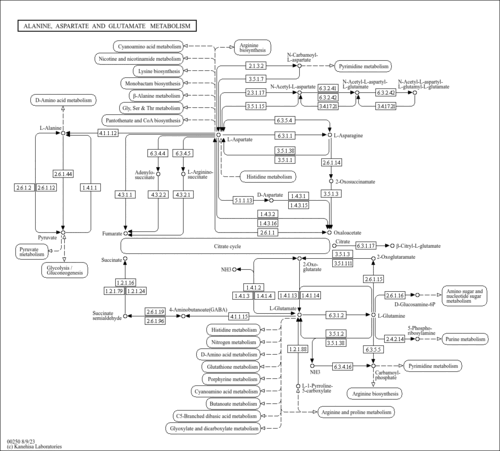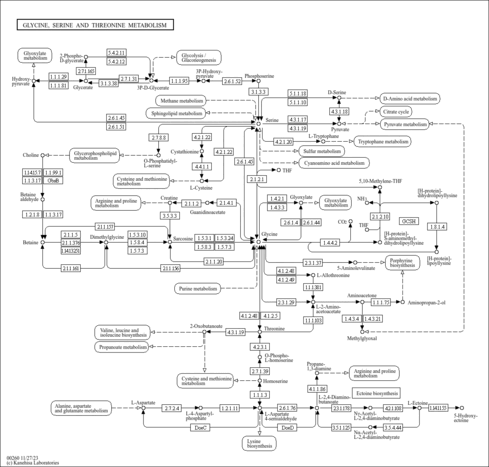| GC-MS Spectra| Spectrum Type | Description | Splash Key | Deposition Date | Source | View |
|---|
| Experimental GC-MS | GC-MS Spectrum - Glyoxylic acid GC-MS (1 MEOX; 1 TMS) | splash10-03di-3900000000-16bc69e0e9d51e54854e | 2014-06-16 | HMDB team, MONA, MassBank | View Spectrum | | Experimental GC-MS | GC-MS Spectrum - Glyoxylic acid GC-MS (Non-derivatized) | splash10-03di-3900000000-16bc69e0e9d51e54854e | 2017-09-12 | HMDB team, MONA, MassBank | View Spectrum | | Predicted GC-MS | Predicted GC-MS Spectrum - Glyoxylic acid GC-MS (Non-derivatized) - 70eV, Positive | splash10-0096-9000000000-042540a05be250278f8b | 2016-09-22 | Wishart Lab | View Spectrum | | Predicted GC-MS | Predicted GC-MS Spectrum - Glyoxylic acid GC-MS (1 TMS) - 70eV, Positive | splash10-00fr-9200000000-c60b627ed670285ec37f | 2017-10-06 | Wishart Lab | View Spectrum | | Predicted GC-MS | Predicted GC-MS Spectrum - Glyoxylic acid GC-MS (Non-derivatized) - 70eV, Positive | Not Available | 2021-10-12 | Wishart Lab | View Spectrum | | Predicted GC-MS | Predicted GC-MS Spectrum - Glyoxylic acid GC-MS (TBDMS_1_1) - 70eV, Positive | Not Available | 2021-11-05 | Wishart Lab | View Spectrum | | MS | Mass Spectrum (Electron Ionization) | splash10-004l-9000000000-a04bafbf8e0b990094a3 | 2014-09-20 | Not Available | View Spectrum |
MS/MS Spectra| Spectrum Type | Description | Splash Key | Deposition Date | Source | View |
|---|
| Experimental LC-MS/MS | LC-MS/MS Spectrum - Glyoxylic acid Quattro_QQQ 10V, Negative-QTOF (Annotated) | splash10-00di-9000000000-72c34bc34b8c3341442b | 2012-07-24 | HMDB team, MONA | View Spectrum | | Experimental LC-MS/MS | LC-MS/MS Spectrum - Glyoxylic acid Quattro_QQQ 25V, Negative-QTOF (Annotated) | splash10-00di-9000000000-920a0dc738957201d4ba | 2012-07-24 | HMDB team, MONA | View Spectrum | | Experimental LC-MS/MS | LC-MS/MS Spectrum - Glyoxylic acid Quattro_QQQ 40V, Negative-QTOF (Annotated) | splash10-00di-9000000000-857c7f2d72c3d4c10dbf | 2012-07-24 | HMDB team, MONA | View Spectrum | | Experimental LC-MS/MS | LC-MS/MS Spectrum - Glyoxylic acid LC-ESI-QQ (API3000, Applied Biosystems) 10V, Negative-QTOF | splash10-00di-9000000000-9b5825d5d9d8b094fefa | 2012-08-31 | HMDB team, MONA | View Spectrum | | Experimental LC-MS/MS | LC-MS/MS Spectrum - Glyoxylic acid LC-ESI-QQ (API3000, Applied Biosystems) 20V, Negative-QTOF | splash10-00di-9000000000-de556f03ea428deff5e2 | 2012-08-31 | HMDB team, MONA | View Spectrum | | Experimental LC-MS/MS | LC-MS/MS Spectrum - Glyoxylic acid LC-ESI-QQ (API3000, Applied Biosystems) 30V, Negative-QTOF | splash10-00dl-9000000000-74b253632894213d473c | 2012-08-31 | HMDB team, MONA | View Spectrum | | Experimental LC-MS/MS | LC-MS/MS Spectrum - Glyoxylic acid LC-ESI-QQ , negative-QTOF | splash10-00di-9000000000-9b5825d5d9d8b094fefa | 2017-09-14 | HMDB team, MONA | View Spectrum | | Experimental LC-MS/MS | LC-MS/MS Spectrum - Glyoxylic acid LC-ESI-QQ , negative-QTOF | splash10-00di-9000000000-de556f03ea428deff5e2 | 2017-09-14 | HMDB team, MONA | View Spectrum | | Experimental LC-MS/MS | LC-MS/MS Spectrum - Glyoxylic acid LC-ESI-QQ , negative-QTOF | splash10-00dl-9000000000-74b253632894213d473c | 2017-09-14 | HMDB team, MONA | View Spectrum | | Predicted LC-MS/MS | Predicted LC-MS/MS Spectrum - Glyoxylic acid 10V, Positive-QTOF | splash10-004i-9000000000-a8cc2c89793394fdf9e4 | 2015-04-24 | Wishart Lab | View Spectrum | | Predicted LC-MS/MS | Predicted LC-MS/MS Spectrum - Glyoxylic acid 20V, Positive-QTOF | splash10-0a6r-9000000000-d20183b08984d4766e8a | 2015-04-24 | Wishart Lab | View Spectrum | | Predicted LC-MS/MS | Predicted LC-MS/MS Spectrum - Glyoxylic acid 40V, Positive-QTOF | splash10-0a4i-9000000000-ea9968e3933fd734506c | 2015-04-24 | Wishart Lab | View Spectrum | | Predicted LC-MS/MS | Predicted LC-MS/MS Spectrum - Glyoxylic acid 10V, Negative-QTOF | splash10-00di-9000000000-cef8efc477a2500a7ead | 2015-04-25 | Wishart Lab | View Spectrum | | Predicted LC-MS/MS | Predicted LC-MS/MS Spectrum - Glyoxylic acid 20V, Negative-QTOF | splash10-00di-9000000000-3817c0865df629803538 | 2015-04-25 | Wishart Lab | View Spectrum | | Predicted LC-MS/MS | Predicted LC-MS/MS Spectrum - Glyoxylic acid 40V, Negative-QTOF | splash10-00di-9000000000-bb935f857fb5fd08c7e3 | 2015-04-25 | Wishart Lab | View Spectrum | | Predicted LC-MS/MS | Predicted LC-MS/MS Spectrum - Glyoxylic acid 10V, Positive-QTOF | splash10-0a4i-9000000000-8f50f0d32d4c40b5b935 | 2021-09-24 | Wishart Lab | View Spectrum | | Predicted LC-MS/MS | Predicted LC-MS/MS Spectrum - Glyoxylic acid 20V, Positive-QTOF | splash10-0a4i-9000000000-b6216caa16afdf328489 | 2021-09-24 | Wishart Lab | View Spectrum | | Predicted LC-MS/MS | Predicted LC-MS/MS Spectrum - Glyoxylic acid 40V, Positive-QTOF | splash10-0a4i-9000000000-aa6a654e73df38a43273 | 2021-09-24 | Wishart Lab | View Spectrum | | Predicted LC-MS/MS | Predicted LC-MS/MS Spectrum - Glyoxylic acid 10V, Negative-QTOF | splash10-00di-9000000000-c6f38ec60bcf8724ecd1 | 2021-09-24 | Wishart Lab | View Spectrum | | Predicted LC-MS/MS | Predicted LC-MS/MS Spectrum - Glyoxylic acid 20V, Negative-QTOF | splash10-00di-9000000000-c6f38ec60bcf8724ecd1 | 2021-09-24 | Wishart Lab | View Spectrum | | Predicted LC-MS/MS | Predicted LC-MS/MS Spectrum - Glyoxylic acid 40V, Negative-QTOF | splash10-00dl-9000000000-641421c616a0929ce01e | 2021-09-24 | Wishart Lab | View Spectrum |
NMR Spectra| Spectrum Type | Description | Deposition Date | Source | View |
|---|
| Experimental 1D NMR | 1H NMR Spectrum (1D, 600 MHz, H2O, experimental) | 2012-12-04 | Wishart Lab | View Spectrum | | Predicted 1D NMR | 1H NMR Spectrum (1D, 100 MHz, D2O, predicted) | 2021-09-29 | Wishart Lab | View Spectrum | | Predicted 1D NMR | 13C NMR Spectrum (1D, 100 MHz, D2O, predicted) | 2021-09-29 | Wishart Lab | View Spectrum | | Predicted 1D NMR | 1H NMR Spectrum (1D, 1000 MHz, D2O, predicted) | 2021-09-29 | Wishart Lab | View Spectrum | | Predicted 1D NMR | 13C NMR Spectrum (1D, 1000 MHz, D2O, predicted) | 2021-09-29 | Wishart Lab | View Spectrum | | Predicted 1D NMR | 1H NMR Spectrum (1D, 200 MHz, D2O, predicted) | 2021-09-29 | Wishart Lab | View Spectrum | | Predicted 1D NMR | 13C NMR Spectrum (1D, 200 MHz, D2O, predicted) | 2021-09-29 | Wishart Lab | View Spectrum | | Predicted 1D NMR | 1H NMR Spectrum (1D, 300 MHz, D2O, predicted) | 2021-09-29 | Wishart Lab | View Spectrum | | Predicted 1D NMR | 13C NMR Spectrum (1D, 300 MHz, D2O, predicted) | 2021-09-29 | Wishart Lab | View Spectrum | | Predicted 1D NMR | 1H NMR Spectrum (1D, 400 MHz, D2O, predicted) | 2021-09-29 | Wishart Lab | View Spectrum | | Predicted 1D NMR | 13C NMR Spectrum (1D, 400 MHz, D2O, predicted) | 2021-09-29 | Wishart Lab | View Spectrum | | Predicted 1D NMR | 1H NMR Spectrum (1D, 500 MHz, D2O, predicted) | 2021-09-29 | Wishart Lab | View Spectrum | | Predicted 1D NMR | 13C NMR Spectrum (1D, 500 MHz, D2O, predicted) | 2021-09-29 | Wishart Lab | View Spectrum | | Predicted 1D NMR | 1H NMR Spectrum (1D, 600 MHz, D2O, predicted) | 2021-09-29 | Wishart Lab | View Spectrum | | Predicted 1D NMR | 13C NMR Spectrum (1D, 600 MHz, D2O, predicted) | 2021-09-29 | Wishart Lab | View Spectrum | | Predicted 1D NMR | 1H NMR Spectrum (1D, 700 MHz, D2O, predicted) | 2021-09-29 | Wishart Lab | View Spectrum | | Predicted 1D NMR | 13C NMR Spectrum (1D, 700 MHz, D2O, predicted) | 2021-09-29 | Wishart Lab | View Spectrum | | Predicted 1D NMR | 1H NMR Spectrum (1D, 800 MHz, D2O, predicted) | 2021-09-29 | Wishart Lab | View Spectrum | | Predicted 1D NMR | 13C NMR Spectrum (1D, 800 MHz, D2O, predicted) | 2021-09-29 | Wishart Lab | View Spectrum | | Predicted 1D NMR | 1H NMR Spectrum (1D, 900 MHz, D2O, predicted) | 2021-09-29 | Wishart Lab | View Spectrum | | Predicted 1D NMR | 13C NMR Spectrum (1D, 900 MHz, D2O, predicted) | 2021-09-29 | Wishart Lab | View Spectrum | | Experimental 2D NMR | [1H, 13C]-HSQC NMR Spectrum (2D, 600 MHz, H2O, experimental) | 2012-12-04 | Wishart Lab | View Spectrum |
IR Spectra| Spectrum Type | Description | Deposition Date | Source | View |
|---|
| Predicted IR Spectrum | IR Ion Spectrum (Predicted IRIS Spectrum, Adduct: [M-H]-) | 2023-02-03 | FELIX lab | View Spectrum | | Predicted IR Spectrum | IR Ion Spectrum (Predicted IRIS Spectrum, Adduct: [M+H]+) | 2023-02-03 | FELIX lab | View Spectrum | | Predicted IR Spectrum | IR Ion Spectrum (Predicted IRIS Spectrum, Adduct: [M+Na]+) | 2023-02-03 | FELIX lab | View Spectrum |
| Show more...
|---|
| Disease References | | Transurethral resection of the prostate |
|---|
- Perier C, Mahul P, Molliex S, Auboyer C, Frey J: Progressive changes in glycine and glycine derivatives in plasma and cerebrospinal fluid after transurethral prostatic resection. Clin Chem. 1990 Dec;36(12):2152-3. [PubMed:2253377 ]
| | Bladder infections |
|---|
- Braundmeier-Fleming A, Russell NT, Yang W, Nas MY, Yaggie RE, Berry M, Bachrach L, Flury SC, Marko DS, Bushell CB, Welge ME, White BA, Schaeffer AJ, Klumpp DJ: Stool-based biomarkers of interstitial cystitis/bladder pain syndrome. Sci Rep. 2016 May 18;6:26083. doi: 10.1038/srep26083. [PubMed:27188581 ]
| | Primary hyperoxaluria I |
|---|
- Holmgren G, Hornstrom T, Johansson S, Samuelson G: Primary hyperoxaluria (glycolic acid variant): a clinical and genetical investigation of eight cases. Ups J Med Sci. 1978;83(1):65-70. [PubMed:705974 ]
|
|
|---|
| General References | - Lee SH, Kim SO, Chung BC: Gas chromatographic-mass spectrometric determination of urinary oxoacids using O-(2,3,4,5,6-pentafluorobenzyl)oxime-trimethylsilyl ester derivatization and cation-exchange chromatography. J Chromatogr B Biomed Sci Appl. 1998 Nov 20;719(1-2):1-7. [PubMed:9869358 ]
- Booth ED, Dofferhoff O, Boogaard PJ, Watson WP: Comparison of the metabolism of ethylene glycol and glycolic acid in vitro by precision-cut tissue slices from female rat, rabbit and human liver. Xenobiotica. 2004 Jan;34(1):31-48. [PubMed:14742135 ]
- Naghizadeh F, Barlow D, King J: The reduction of oxo-acids by human tissue extracts. Clin Biochem. 1976 Apr;9(2):65-6. [PubMed:1261003 ]
- Borondy PE, Michniewicz BM: Metabolic disposition of isoxicam in man, monkey, dog, and rat. Drug Metab Dispos. 1984 Jul-Aug;12(4):444-51. [PubMed:6148211 ]
- Arvesen A, Maehlen J, Rosen L, Aas P: Myointimal hyperplasia and sympathetic reinnervation following local cold injury and rapid rewarming in the rabbit central ear artery. Vasa. 2001 Jul;30(3):176-83. [PubMed:11582947 ]
- Motomiya Y, Oyama N, Iwamoto H, Uchimura T, Maruyama I: N epsilon-(carboxymethyl)lysine in blood from maintenance hemodialysis patients may contribute to dialysis-related amyloidosis. Kidney Int. 1998 Oct;54(4):1357-66. [PubMed:9767556 ]
- Holmes E, Foxall PJ, Spraul M, Farrant RD, Nicholson JK, Lindon JC: 750 MHz 1H NMR spectroscopy characterisation of the complex metabolic pattern of urine from patients with inborn errors of metabolism: 2-hydroxyglutaric aciduria and maple syrup urine disease. J Pharm Biomed Anal. 1997 Jul;15(11):1647-59. [PubMed:9260660 ]
- Mentasti E, Savigliano M, Marangella M, Petrarulo M, Linari F: High-performance liquid chromatographic determination of glyoxylic acid and other carbonyl compounds in urine. J Chromatogr. 1987 Jul 3;417(2):253-60. [PubMed:3654878 ]
- Bruzzese FJ, Dix JA, Rava RP, Cerny LC: Resonance Raman spectroscopy of chemically modified hemoglobins. Biomater Artif Cells Artif Organs. 1990;18(2):143-56. [PubMed:2369642 ]
- Schmitt A, Gasic-Milenkovic J, Schmitt J: Characterization of advanced glycation end products: mass changes in correlation to side chain modifications. Anal Biochem. 2005 Nov 1;346(1):101-6. Epub 2005 Aug 15. [PubMed:16168380 ]
- Tainio H, Vaalasti A, Rechardt L: The distribution of sympathetic adrenergic, tyrosine hydroxylase- and neuropeptide Y-immunoreactive nerves in human axillary sweat glands. Histochemistry. 1986;85(2):117-20. [PubMed:2875046 ]
- Davis WL, Goodman DB: Evidence for the glyoxylate cycle in human liver. Anat Rec. 1992 Dec;234(4):461-8. [PubMed:1456449 ]
- Arvesen A, Maehlen J, Rosen L, Aas P: Early and late functional and histopathological perturbations in the rabbit ear-artery following local cold injury. Vasa. 1999 May;28(2):85-94. [PubMed:10409918 ]
- Popov VN, Moskalev EA, Shevchenko MIu, Eprintsev AT: [Comparative analysis of the glyoxylate cycle clue enzyme isocitrate lyases from organisms of different systemic groups]. Zh Evol Biokhim Fiziol. 2005 Nov-Dec;41(6):507-13. [PubMed:16396466 ]
| Show more...
|---|

